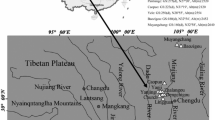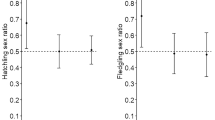Summary
There is a range of egg size phenotypes in Mallards (Anas platyrhynchos) that has a large genetic component. It was hypothesized that egg size variation could play an important role in survival of newly hatched ducklings during their first few days out of the nest when they are most susceptible to thermal stress and starvation. Precocial young must be physiologically capable of maintaining homeothermy in order to spend adequate time foraging. Duckling size at hatching was highly correlated with egg mass, and those hatching from heavier eggs were able to maintain homeothermy at colder environmental temperatures than those from lighter eggs. Heavy ducklings had significantly lower mass-specific cooling rates, but lower critical temperature did not vary significantly among ducklings of different size. Although insulation and energy reserves were not proportionally greater in larger ducklings, those hatching from heavier eggs can survive starvation longer than those from lighter eggs. The relative cold tolerance of young from light and heavy eggs will affect the ratio of time spent foraging to time spent being brooded by the female parent. Although there is no direct evidence that selection is acting on egg size, variation in this trait within a population could be maintained by fluctuating environmental conditions at hatch.
Similar content being viewed by others
References
Ankney CD (1980) Egg weight, survival and growth of Lesser Snow Goose goslings. J Wildl Man 44:174–182
Bakken GS (1976) A heat transfer analysis of animals: unifying concepts and the application of metabolic chamber data to field ecology. J Theor Biol 60:337–384
Ball IJ, Gilmer DS, Cowardin LM, Riechmann JH (1975) Survival of Wood Duck and Mallard broods in North-central Minnesota. J Wildl Man 39:776–780
Batt BDJ, Prince HH (1979) Laying date, clutch size and egg weight of captive Mallards. Condor 81:35–41
Blem C (1974) Geographic variation of thermal conductance in the House Sparrow Passer domesticus. Comp Biochem Physiol 47:101–108
Calder WA (1974) Consequences of body size for avian energetics. In: Paynter RA (ed) Avian energetics. Nutall Ornithol Club Publ No 15, Cambridge, Mass, pp 86–151
Capinera JL (1979) Qualitative variation in plants and insects: effect of propagule size on ecological plasticity. Am Nat 114:350–361
Case TJ (1978) Endothermy and parental care in the terrestrial vertebrates. Am Nat 112:861–874
Chappell MA (1980) Thermal energetics of chicks of arctic-breeding shorebirds. Comp Biochem Physiol 65A:311–317
Cole R (1979) The relationship between weight at hatch and survival and growth of Lesser Snow Geese. Unpubl MSc thesis, Univ Western Ontario, London
Dzubin A, Gollop JB (1972) Aspects of Mallard breeding ecology in Canadian parkland and grassland. In: Population ecology of migratory birds. U.S. Fish Wildl Serv Res Rpt 2, pp 113–152
Falconer DS (1960) Introduction to quantitative genetics. Longman, N.Y.
Hill RW (1972) Determination of oxygen consumption by use of the paramagnetic oxygen analyzer. J Physiol 33:261–263
Istock CA (1983) The extent and consequences of heritable variation for fitness characters. In: King CR, Dawson PS (eds) Population biology: retrospect and prospect. Columbia Univ Press, N.Y., pp 61–96
Kaplan RH (1980) The implication of ovum size variability for offspring fitness and clutch size within several populations of salamanders (Ambystoma). Evolution 34:51–64
Kear J (1965) The internal food reserves of hatching Mallard ducklings. J Wildl Man 29:523–528
Kendeigh SC (1970) Energy requirements for existence in relation to size in birds. Condor 72:60–65
Koskimies J, Lahti L (1964) Cold hardiness of the newly hatched young in relation to ecology and distribution in ten species of European ducks. Auk 81:281–307
Krapu GL (1979) Nutrition of female dabbling ducks during reproduction. In: Bookhout TA (ed) Waterfowl and wetlands — an integrated review. Proc 1977 Symp N Cent Sect The Wildlife Society, Madison, Wisconsin, pp 59–70
Lundberg CA, Vaisanen RA (1979) Selective correlation of egg size with chick mortality in the Black-headed Gull (Larus ridibundus). Condor 81:146–156
Mahoney SA, King JR (1977) The use of equivalent black-body temperature in the thermal energetics of small birds. J Therm Biol 2:115–120
Moss RA, Watson A (1982) Heritability of egg size, hatch weight, body weight and viability in Red Grouse (lagopus lagopus scoticus). Auk 99:683–686
Noordwijk AJ van, Keizer LCP, Balen JH van, Scharloo W van (1981) Genetic variation in egg dimensions in natural populations of the Great Tit. Genetica 55:221–232
Porter WP (1969) Thermal radiation in metabolism chambers. Science 166:115–117
Prince HH, Siegel PB, Cornwell GW (1970) Inheritance of egg production and juvenile growth in Mallards. Auk 87:342–352
Randall EL (1974) Improved method for fat and oil analysis by a new process of extraction. J Am Anal Chem 57:1165–1168
Rhymer JM (1983) Effect of egg size and renesting on thermoregulatory ability and growth of Mallard ducklings. Unpubl MSc thesis, Univ of Manitoba, Winnipeg
Ringleman JK, Flake LD (1980) Diurnal visibility and activity of Blue-winged Teal and Mallard broods. J Wildl Manage 44:822–829
SAS Institute Inc. 1982. SAS user's guide: statistics SAS Institute, Cary, N.C.
Schifferli L (1973) The effect of egg weight on the subsequent growth of nestling Great Tits (Parus major). Ibis 115:549–558
Scholander PF (1955) Evolution of climatic adaptation in homeotherms. Evolution 9:15–26
Street M (1977) The food of Mallard ducklings in a wet gravel quarry and its relation to duckling survival. Wildfowl 28:113–125
Talent LG, Jarvis RL, Krapu GL (1983) Survival of Mallard broods in south-central North Dakota Condor 85:74–78
Author information
Authors and Affiliations
Rights and permissions
About this article
Cite this article
Rhymer, J.M. The effect of egg size variability on thermoregulation of Mallard (Anas platyrhynchos) offspring and its implications for survival. Oecologia 75, 20–24 (1988). https://doi.org/10.1007/BF00378809
Received:
Issue Date:
DOI: https://doi.org/10.1007/BF00378809




